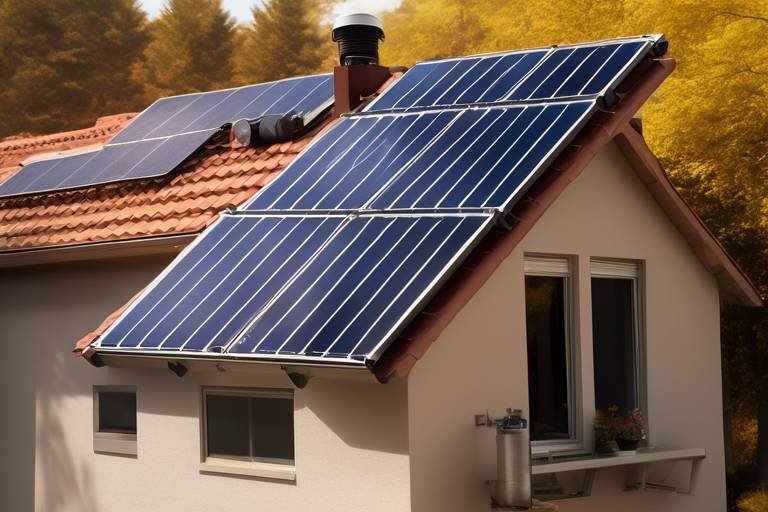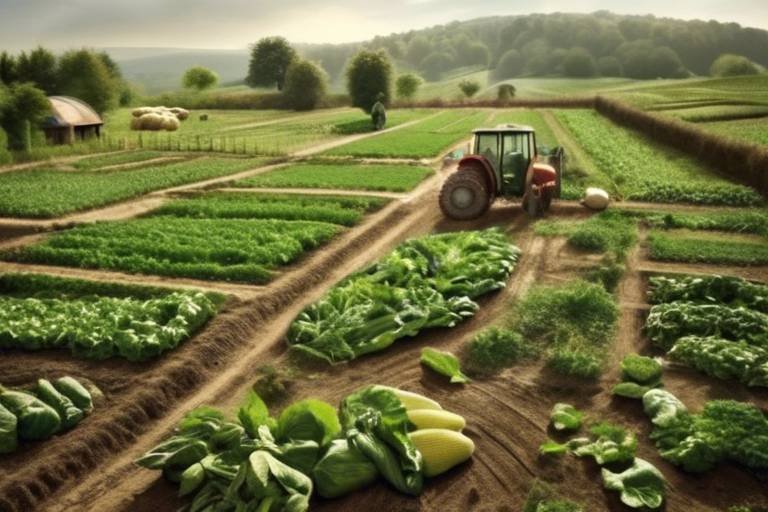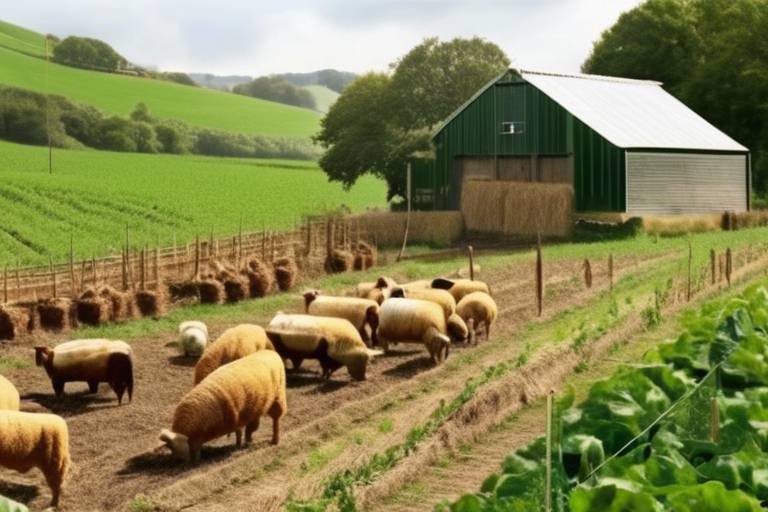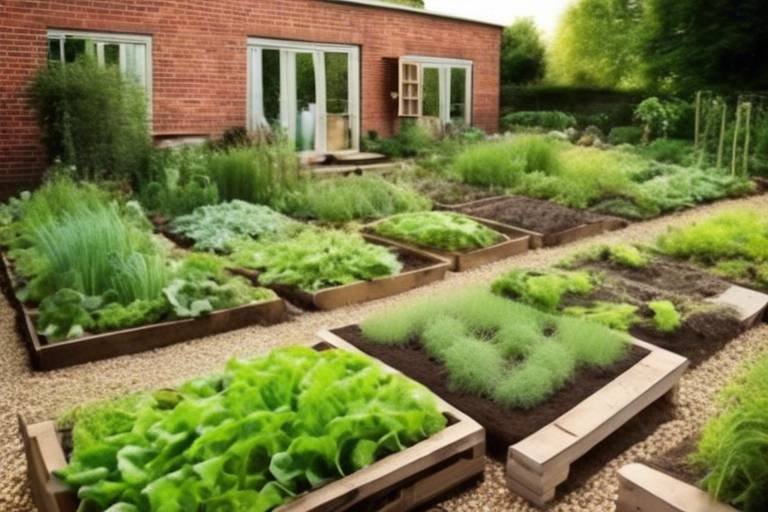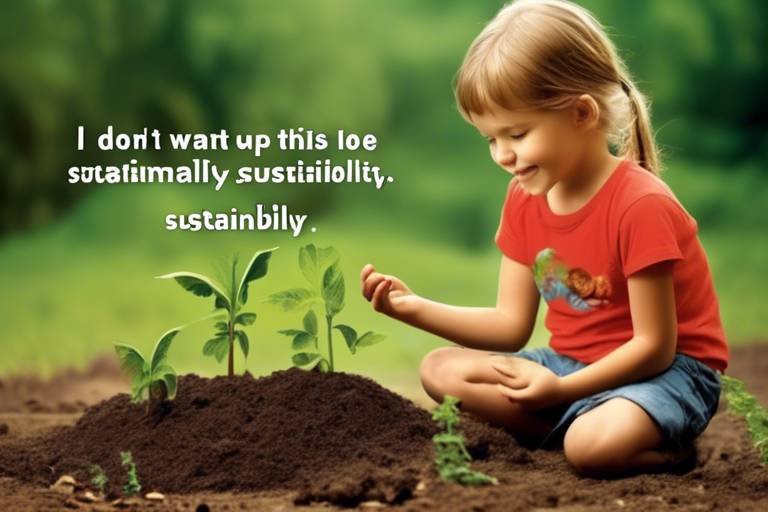Top Books to Learn About Sustainable Living
Discovering the world of sustainable living can feel like stepping into a vast forest—there's so much to explore, but where do you start? One of the best ways to embark on this journey is through reading. Books have the power to enlighten us, challenge our perspectives, and inspire meaningful change in our lives. In this article, we will delve into a selection of essential reads that not only provide insights into sustainable living practices but also cultivate a deeper environmental awareness. Whether you're a seasoned eco-warrior or just beginning to consider your ecological footprint, these influential books will guide you on your path toward a more sustainable lifestyle.
As we navigate through the pages of these texts, we’ll uncover the wisdom of authors who have dedicated their lives to understanding the intricate relationship between humanity and the environment. From classic literature that laid the groundwork for environmentalism to modern guides filled with practical advice, these books are more than just words on a page—they are a call to action. So, grab your favorite reading nook, a cup of herbal tea, and let’s dive into the world of sustainable living literature!
Sustainability is more than just a buzzword; it’s a vital concept that underscores our responsibility to protect the planet for future generations. In a world where climate change, pollution, and resource depletion are pressing concerns, understanding sustainability is crucial. It encourages us to think critically about our consumption habits and the impact they have on the environment. Literature plays a significant role in shaping our understanding of these issues, offering insights and sparking conversations that can lead to action.
By exploring the works of influential authors, we can learn about the importance of living in harmony with nature. These texts often challenge us to reflect on our values and the choices we make daily. They inspire us to adopt more eco-friendly practices and become advocates for change in our communities. In short, literature can be a powerful tool for fostering environmental awareness and driving the movement toward a sustainable future.
To truly appreciate the journey toward sustainability, it’s essential to understand the foundational texts that have paved the way for modern environmental thought. These classic works not only highlight the challenges we face but also provide timeless wisdom on how to address them. They serve as a reminder of the enduring nature of the fight for a healthier planet.
Considered a catalyst for the environmental movement, Silent Spring by Rachel Carson is a must-read for anyone interested in sustainability. Released in 1962, this groundbreaking book raises awareness about the dangers of pesticide use and its devastating impact on wildlife and ecosystems. Carson's eloquent prose and compelling arguments encourage readers to consider their ecological footprint and the broader implications of human actions on the natural world.
Published in 1972, The Limits to Growth presents a thought-provoking analysis of the consequences of unchecked growth and resource depletion. This influential report challenges the notion that economic growth can continue indefinitely without severe environmental repercussions. It urges readers to rethink traditional economic models and consider sustainable development as a viable alternative.
In Walden, Henry David Thoreau reflects on his experiment in simple living amidst nature. His insights promote a lifestyle that values self-sufficiency and a deep connection with the environment. Thoreau's appreciation for the beauty of simplicity resonates with readers, inspiring them to embrace a more mindful approach to life and the natural world.
As we transition into contemporary literature, we find a wealth of resources that provide practical advice on how to live sustainably. These modern guides are filled with actionable tips and strategies for integrating eco-friendly practices into our daily lives. They empower readers to take charge of their environmental impact and make conscious choices.
Bea Johnson's The Zero Waste Home is a comprehensive guide that outlines practical steps for reducing waste in everyday life. Johnson emphasizes the importance of adopting a minimalist mindset, offering creative solutions for sustainable living. This book encourages readers to rethink their consumption habits and embrace a lifestyle that prioritizes sustainability.
In How to Give Up Plastic, the author provides valuable insights into the pervasive issue of plastic consumption and its environmental impact. This book is a treasure trove of practical advice and alternatives, empowering readers to make conscious choices that contribute to a cleaner planet. It’s a wake-up call for anyone looking to reduce their reliance on single-use plastics.
Barbara Kingsolver's memoir, Animal, Vegetable, Miracle, chronicles her family's journey toward sustainable farming and local eating. Through engaging storytelling, Kingsolver emphasizes the importance of food choices and their connection to environmental health. This book inspires readers to support local agriculture and make informed decisions about their food sources.
As we look to the future, the conversation around sustainability continues to evolve. New voices and ideas are emerging, shaping the literature that guides us toward a more sustainable world. These contemporary authors are not only addressing current challenges but also envisioning innovative solutions that inspire hope and action.
In conclusion, the journey toward sustainable living is one that is enriched by the wisdom found in literature. The books discussed in this article serve as essential guides, offering insights, inspiration, and practical advice for those looking to make a positive impact on the planet. By immersing ourselves in these texts, we can arm ourselves with knowledge and become advocates for a more sustainable future.
- What is sustainable living? Sustainable living refers to making choices that reduce our environmental impact and promote the health of the planet.
- Why is reading about sustainability important? Reading about sustainability helps raise awareness, inspires action, and provides practical advice for living a more eco-friendly lifestyle.
- Can classic books on environmentalism still be relevant today? Absolutely! Classic texts provide foundational knowledge and timeless insights that continue to influence modern environmental thought.
- How can I start living more sustainably? Begin by educating yourself through literature, making small changes in your daily habits, and seeking out local resources that promote sustainability.

Understanding Sustainability
Sustainability is more than just a buzzword; it's a vital concept that shapes the way we interact with our planet. In today's fast-paced world, where environmental degradation is becoming increasingly evident, understanding sustainability is crucial for both individuals and communities. But what does it really mean? At its core, sustainability refers to meeting our own needs without compromising the ability of future generations to meet theirs. It encompasses a balance between environmental health, economic viability, and social equity.
Imagine a world where every action we take contributes to the well-being of our planet. That’s the essence of sustainability! It’s about making choices that not only benefit us today but also pave the way for a healthier Earth tomorrow. This means being aware of our ecological footprint and recognizing how our daily habits—like the food we eat, the products we buy, and the energy we consume—impact the environment.
Literature plays a significant role in shaping our understanding of sustainability. Through the pages of books, we gain insights into the challenges our world faces, as well as the innovative solutions that can lead us towards a more sustainable future. Books can inspire us to take action, challenge our assumptions, and broaden our perspectives on what it means to live sustainably.
As we delve deeper into the topic, it's essential to recognize the interconnectedness of various elements of sustainability. Here are some key aspects to consider:
- Environmental Awareness: Understanding how our actions affect the natural world is crucial. This includes recognizing issues like climate change, pollution, and biodiversity loss.
- Eco-Friendly Choices: Sustainable living encourages us to make choices that minimize harm to the environment, such as reducing waste and conserving resources.
- Community Engagement: Sustainability is not just an individual effort; it involves working together as a community to implement changes that benefit everyone.
In summary, grasping the concept of sustainability is the first step towards making a meaningful impact. By reading and engaging with literature on this topic, we can equip ourselves with the knowledge and tools needed to contribute to a more sustainable world. So, are you ready to take that first step? Let's explore the transformative power of literature in our journey towards sustainability!

Classic Texts on Environmentalism
When we think about the roots of the environmental movement, certain classic texts come to mind that have shaped our understanding of sustainability and conservation. These works are not just books; they are beacons of wisdom that have illuminated the path towards a more sustainable future. They challenge us to consider our relationship with the earth and inspire us to take action. In this section, we will explore some of the most influential texts that laid the groundwork for modern environmentalism.
One of the most pivotal works in this genre is Silent Spring by Rachel Carson. Published in 1962, this groundbreaking book raised the alarm about the dangers of pesticide use, particularly DDT, and its devastating impact on wildlife and ecosystems. Carson's eloquent prose and meticulous research not only educated the public but also galvanized the environmental movement, prompting a reevaluation of how we interact with our natural surroundings. Her work serves as a reminder that our choices have consequences, and it encourages readers to consider their ecological footprint.
Another seminal text is The Limits to Growth, a report published in 1972 by the Club of Rome. This influential document utilized computer modeling to predict the consequences of unchecked growth and resource depletion. It argued that if humanity continued on its current trajectory, we would face dire consequences, including environmental collapse. The book challenged readers to rethink the notion of economic growth and consider sustainable development as a viable alternative. Its message remains relevant today, serving as a crucial call to action for policymakers and individuals alike.
Then there's Walden by Henry David Thoreau, a reflective narrative that promotes simple living in natural surroundings. Thoreau's experiment in self-sufficiency at Walden Pond is not just a tale of solitude; it is a profound exploration of our connection to nature. He advocates for a lifestyle that values simplicity and encourages readers to appreciate the beauty of the world around them. Thoreau's insights remind us that sometimes, stepping back from the chaos of modern life can lead to a deeper understanding of our place in the ecosystem.
These classic texts continue to resonate with readers today, serving as foundational knowledge for anyone interested in environmentalism. They remind us that the fight for a sustainable future is not new; it has deep roots in our literature. By engaging with these works, we can better understand the historical context of our current environmental challenges and be inspired to take meaningful action.
| Book Title | Author | Year Published | Key Themes |
|---|---|---|---|
| Silent Spring | Rachel Carson | 1962 | Pesticides, Ecology, Environmental Awareness |
| The Limits to Growth | Club of Rome | 1972 | Resource Depletion, Economic Growth, Sustainability |
| Walden | Henry David Thoreau | 1854 | Simple Living, Nature, Self-Sufficiency |

Silent Spring by Rachel Carson
Silent Spring is not just a book; it’s a clarion call to humanity, written by the remarkable Rachel Carson in 1962. This groundbreaking work ignited the environmental movement and remains a cornerstone of ecological literature. Carson meticulously documented the devastating effects of pesticide use, particularly focusing on the infamous chemical DDT. Through compelling storytelling and scientific evidence, she painted a vivid picture of a world where nature is silenced by human actions. Imagine waking up to a spring where the songs of birds are replaced by silence—this haunting image is what Carson warns us about.
Carson's prose is both poetic and poignant, making complex scientific concepts accessible to the average reader. She emphasizes the interconnectedness of all living things, reminding us that our actions have consequences. The book challenges us to reflect on our ecological footprint and the impact of our choices on the planet. It’s an invitation to consider not only what we consume but also how we contribute to the degradation of our environment.
One of the most striking aspects of Silent Spring is its ability to stir emotions while presenting factual information. Carson uses a narrative style that engages readers, making them feel as if they are part of the unfolding story of environmental destruction. She illustrates how pesticides not only kill pests but also harm beneficial insects, birds, and even humans. This ripple effect is a crucial takeaway from her work, urging us to think critically about the chemicals we use in our daily lives.
Additionally, Carson’s work sparked a nationwide debate about environmental policy and regulation. As a result, it led to the eventual establishment of the Environmental Protection Agency (EPA) and the banning of DDT in the United States. This demonstrates the power of literature to inspire change and mobilize action. Carson's voice resonates through time, reminding us that it is our responsibility to protect the delicate balance of our ecosystems.
In summary, Silent Spring is more than just a book; it’s a powerful manifesto advocating for a sustainable future. It encourages readers to become stewards of the earth, to engage in conversations about environmental responsibility, and to make informed choices that benefit both the planet and future generations. As we navigate the complexities of modern living, Carson’s words remain a guiding light, urging us to listen to the whispers of nature before they fade into silence.
- What is the main message of Silent Spring?
The main message of Silent Spring is to raise awareness about the dangers of pesticide use and its impact on the environment, urging readers to consider the consequences of their actions on nature.
- How did Silent Spring influence environmental policy?
Silent Spring played a crucial role in the environmental movement, leading to increased public awareness and the eventual establishment of regulatory bodies like the Environmental Protection Agency (EPA).
- Why is Silent Spring still relevant today?
The themes of Silent Spring, such as the interconnectedness of ecosystems and the dangers of chemical pollution, are still relevant as we face ongoing environmental challenges and seek sustainable solutions.

The Limits to Growth
is a seminal report published in 1972 by the Club of Rome, which has profoundly influenced the discourse surrounding sustainability and environmental conservation. This groundbreaking work presents a compelling analysis of the potential consequences of unchecked economic and population growth on our planet's finite resources. The authors utilized computer modeling to project various scenarios, highlighting the urgent need for a shift in how we perceive growth and development in relation to environmental sustainability.
At its core, the report argues that if current trends in population growth, industrialization, pollution, food production, and resource depletion continue unchecked, the world will face catastrophic consequences by the middle of the 21st century. The authors emphasized that the earth has physical limits, and crossing these limits could lead to ecological collapse. This notion is particularly relevant today as we witness the effects of climate change, biodiversity loss, and resource scarcity.
To illustrate their points, the report outlines several key factors that contribute to the limits of growth:
- Population Growth: Rapid increases in population place immense pressure on natural resources, leading to overconsumption and environmental degradation.
- Resource Depletion: The relentless extraction of non-renewable resources, such as fossil fuels and minerals, is unsustainable and poses a threat to future generations.
- Pollution: Industrial activities and waste generation contribute to the degradation of air, water, and soil quality, affecting both human health and ecosystems.
- Food Production: Agricultural practices that prioritize high yields often lead to soil depletion and loss of biodiversity, jeopardizing food security.
The report's findings sparked widespread debate and prompted a reevaluation of economic policies and practices. It challenged the prevailing notion that growth is inherently positive and suggested that a new paradigm—one that prioritizes sustainability and ecological balance—must be adopted. This shift in mindset is crucial for fostering a sustainable future, as it encourages individuals, businesses, and governments to consider the long-term impacts of their actions on the environment.
In conclusion, serves as a wake-up call, urging us to rethink our approach to development and resource management. It emphasizes the importance of living within our means and recognizing the interconnectedness of economic, social, and environmental systems. By heeding its warnings and embracing sustainable practices, we can pave the way for a healthier planet and a more equitable future.

Walden by Henry David Thoreau
Walden is not just a book; it’s a profound experience that invites readers to step into the shoes of one of America’s most influential thinkers, Henry David Thoreau. Written during his two-year experiment in simple living at Walden Pond, Thoreau's reflections on nature, self-sufficiency, and the essence of life resonate deeply in today’s fast-paced world. Imagine a life stripped down to its essentials, where the beauty of nature is not just observed but truly felt. Thoreau challenges us to reconsider our relationship with the environment and the artificial constructs of society that often lead us away from what truly matters.
Thoreau's narrative is rich with vivid descriptions of the natural world, capturing the changing seasons and the tranquility of his surroundings. He eloquently argues that simplicity is the key to a fulfilling life, encouraging readers to embrace a lifestyle that prioritizes connection with nature over material possessions. His famous quote, “I went to the woods because I wished to live deliberately,” encapsulates the essence of his philosophy—living with intention and mindfulness.
In Walden, Thoreau explores several themes that remain relevant today:
- Self-Reliance: Thoreau emphasizes the importance of independence and self-sufficiency, advocating for a life where individuals are in tune with their needs and desires.
- Nature Appreciation: His deep admiration for the natural world encourages readers to seek solace and inspiration in the outdoors, fostering a sense of stewardship for the environment.
- Critique of Consumerism: Thoreau critiques the relentless pursuit of wealth and material goods, urging us to question societal norms that prioritize consumption over meaningful experiences.
Moreover, Thoreau’s insights into the rhythms of nature remind us that we are part of a larger ecosystem. His observations about the changing seasons serve as a metaphor for life’s cycles, reinforcing the idea that embracing change is essential for growth. By immersing ourselves in the natural world, we can find clarity and purpose, much like Thoreau did during his time at Walden Pond.
In conclusion, Walden is more than a mere reflection on nature; it’s a call to action. Thoreau invites us to examine our lives critically, encouraging us to strip away the unnecessary and focus on what truly enriches our existence. As we navigate the complexities of modern life, his teachings offer a timeless reminder to reconnect with ourselves and the world around us. So, why not take a moment to ponder—what does a simpler, more intentional life look like for you?
Q: What is the main message of Walden?
A: The main message of Walden is to advocate for a simpler, more intentional life that prioritizes self-sufficiency, nature appreciation, and mindfulness over materialism.
Q: How does Thoreau's philosophy relate to modern sustainability?
A: Thoreau's philosophy emphasizes living in harmony with nature, which aligns with modern sustainability practices that encourage eco-friendly choices and a reduced ecological footprint.
Q: Can Walden inspire action towards sustainable living?
A: Absolutely! Thoreau’s reflections on simplicity and self-reliance can inspire readers to adopt more sustainable practices in their daily lives, fostering a deeper connection with the environment.

Modern Guides to Sustainable Living
In today's fast-paced world, the need for sustainable living has never been more critical. Modern guides to sustainable living offer practical advice that can easily be integrated into our daily routines. These books don’t just preach about the importance of sustainability; they provide real-world solutions that empower individuals to take action. Imagine waking up every day knowing that your choices contribute to a healthier planet—sounds great, right? Well, that’s exactly what these guides aim to achieve!
One standout title in this category is The Zero Waste Home by Bea Johnson. This book is a treasure trove of information for anyone looking to minimize their waste. Johnson’s approach is refreshingly simple: she emphasizes the importance of adopting a minimalist mindset. By reducing clutter and focusing on what truly matters, readers can significantly decrease their waste production. She breaks down the process into manageable steps, making it feel less overwhelming. For instance, she encourages readers to tackle their waste in the following areas:
- Refusing: Say no to unnecessary items.
- Reducing: Cut down on what you already have.
- Reusing: Find new uses for items instead of tossing them.
- Recycling: Properly recycle what you can’t refuse, reduce, or reuse.
- Rotting: Compost organic waste.
Bea Johnson’s insights are not only practical but also inspiring, urging readers to rethink their consumption habits. By the end of the book, you’ll feel equipped to make changes that could lead to a dramatic reduction in your environmental footprint.
Another essential read is How to Give Up Plastic. This book dives deep into the pervasive issue of plastic waste and its impact on our environment. The author provides a comprehensive overview of the plastic crisis, explaining how it affects wildlife and ecosystems. More importantly, it offers actionable alternatives to plastic products that we often take for granted. From reusable shopping bags to biodegradable containers, the book is filled with creative solutions that make sustainable living not just a possibility, but a reality.
Then there’s Animal, Vegetable, Miracle by Barbara Kingsolver, which beautifully intertwines personal narrative with practical advice. Kingsolver recounts her family's year-long adventure in sustainable farming and local eating. Through her storytelling, she highlights the importance of knowing where your food comes from and the impact of our food choices on the environment. This book is not just about farming; it’s about cultivating a deeper connection with the food we consume and the land it comes from. It’s like taking a stroll through a farmer’s market, where every bite comes with a story.
By exploring these modern guides, readers can find inspiration and practical steps to incorporate sustainable practices into their lives. Whether it’s reducing waste, opting for local produce, or finding alternatives to plastic, these books serve as valuable resources for anyone eager to make a difference. In a world where environmental issues can often feel overwhelming, these guides remind us that every small action counts and can lead to significant change.
Q: What is sustainable living?
A: Sustainable living refers to making choices that minimize our environmental impact, ensuring that we meet our needs without compromising the ability of future generations to meet theirs. It encompasses practices that promote ecological balance, such as reducing waste, conserving energy, and supporting local economies.
Q: Why is it important to read about sustainable living?
A: Reading about sustainable living helps raise awareness and provides practical solutions to environmental issues. It empowers individuals to make informed choices and encourages a deeper understanding of the impact of our actions on the planet.
Q: Can I start living sustainably without making drastic changes?
A: Absolutely! Sustainable living can begin with small, manageable changes. Start by incorporating one or two practices into your daily routine, such as using reusable bags or reducing plastic consumption. Every little bit helps!

The Zero Waste Home
In a world overflowing with consumer goods and waste, Bea Johnson's book, , serves as a beacon of hope for those eager to tread lightly on the planet. This insightful guide is not just about reducing waste; it's a call to action for anyone looking to embrace a more sustainable lifestyle. Johnson shares her family's journey towards minimizing waste, offering practical steps that anyone can incorporate into their daily routine. Imagine living in a home where the trash can is practically non-existent! Sounds like a dream, right? Well, it’s entirely possible with a little dedication and creativity.
One of the most compelling aspects of Johnson's approach is the philosophy behind zero waste living. It's not merely about throwing less away; it's about rethinking how we consume. Johnson emphasizes a minimalist mindset, encouraging readers to ask themselves: "Do I really need this?" This simple question can lead to profound changes in our purchasing habits and ultimately reduce our ecological footprint. By prioritizing quality over quantity, we can make more informed choices that benefit both our wallets and the environment.
Throughout the book, Johnson introduces the 5 R's of zero waste living: Refuse, Reduce, Reuse, Recycle, and Rot. These principles serve as a roadmap for anyone looking to embark on a zero waste journey:
- Refuse what you do not need: Say no to unnecessary items and single-use plastics.
- Reduce what you do need: Cut down on items that you already own and focus on quality.
- Reuse what you can: Opt for reusable products instead of disposable ones.
- Recycle what you cannot refuse, reduce, or reuse: Ensure that you are recycling responsibly.
- Rot what’s leftover: Compost food scraps and organic waste to enrich the soil.
By implementing these 5 R's, Johnson illustrates how a zero waste lifestyle can be both achievable and rewarding. She provides practical tips for every room in the house, from the kitchen to the bathroom, and even the living room. For instance, she suggests using glass containers for food storage instead of plastic, which not only cuts down on waste but also keeps food fresher for longer. The book is filled with creative solutions that inspire readers to think outside the box.
Moreover, Johnson's narrative is sprinkled with personal anecdotes that make her journey relatable. She recounts the challenges her family faced and how they overcame them, reminding us that the path to sustainability is not always smooth sailing. There are bumps along the way, but every small step counts. Her candid storytelling makes it clear that anyone can start reducing their waste today, regardless of where they are on their sustainability journey.
In conclusion, is more than just a guide; it's an invitation to rethink our relationship with consumption and waste. Johnson's passionate advocacy for a minimalist lifestyle encourages us to embrace our power as consumers. By making conscious choices and adopting a zero waste mindset, we can contribute to a healthier planet. So why not take the plunge? Your future self—and the Earth—will thank you!
1. What is zero waste living?
Zero waste living is a lifestyle aimed at minimizing waste by rethinking consumption habits. It emphasizes reducing, reusing, and recycling, ultimately striving for a home with little to no trash.
2. Can anyone adopt a zero waste lifestyle?
Absolutely! Zero waste living is for everyone, regardless of your current habits. The journey can be gradual, and small changes can lead to significant impacts over time.
3. What are some easy steps to start with zero waste?
You can start by refusing single-use plastics, using reusable bags and containers, and composting organic waste. Every small step counts!
4. Is zero waste living expensive?
While some zero waste alternatives may have a higher upfront cost, they often save money in the long run by eliminating the need for disposable products.
5. How can I encourage my family to join me in zero waste living?
Start by educating them about the benefits of zero waste living, involving them in the process, and making it fun. Celebrate small victories together!

How to Give Up Plastic
In a world overflowing with plastic, the idea of giving it up might seem daunting, but it's more achievable than you think! The journey toward a plastic-free life is not just about eliminating plastic; it's about embracing a lifestyle that prioritizes sustainability and environmental health. Imagine waking up each day, knowing that your choices contribute to a cleaner planet. How empowering is that?
First, let's talk about the impact of plastic. From the oceans choked with debris to the wildlife suffering from ingestion and entanglement, plastic pollution is a pressing issue. By choosing to reduce your plastic consumption, you're not just making a personal choice; you're joining a global movement. So, how do you start this transformative journey?
One of the most effective strategies is to replace single-use plastics with sustainable alternatives. Think about the items you use daily. For example:
- Instead of plastic bags, opt for reusable cloth bags.
- Swap out plastic water bottles for a stainless steel or glass one.
- Use beeswax wraps or silicone lids instead of plastic wrap.
These simple changes may seem small, but they cumulatively make a significant difference. You might be surprised to find that many of these alternatives are not only better for the environment but often more cost-effective in the long run.
Another essential step in giving up plastic is to become a conscious consumer. This means taking the time to research products before purchasing. Look for items with minimal or no packaging, and support brands that prioritize sustainability. It’s like being a detective for the planet—every choice you make can either contribute to the problem or be part of the solution!
Moreover, consider DIY solutions. Many everyday items can be easily made at home, reducing the need for plastic packaging. For example, you can create your own cleaning supplies using simple ingredients like vinegar and baking soda, or make your own beauty products using natural ingredients. The satisfaction of crafting something yourself is unparalleled!
Lastly, remember that this journey is not about perfection; it’s about progress. Celebrate your victories, no matter how small. Each time you refuse a plastic straw or bring your own container to a restaurant, you're making a statement. You're saying, "I care about my planet." And that, my friend, is a powerful message.
As you embark on this journey, you may have questions. To help you navigate the complexities of giving up plastic, let’s address some Frequently Asked Questions below.
- What are some easy swaps to start with? Begin with reusable bags, water bottles, and straws. These are simple changes that have a big impact.
- Is it realistic to eliminate all plastic? While it may be challenging to eliminate all plastic, every small step counts. Focus on reducing where you can.
- How do I handle social situations where plastic is prevalent? Carry your own reusable items and politely decline single-use plastics when offered. Most people will understand and appreciate your commitment.
In conclusion, giving up plastic is a journey filled with learning and growth. With each step you take, you're not only enriching your life but also contributing to a healthier planet. So, are you ready to make the leap?

Animal, Vegetable, Miracle
by Barbara Kingsolver is not just a memoir; it’s a heartfelt journey that invites readers to rethink their relationship with food and nature. The book chronicles a year in the life of Kingsolver and her family as they commit to a local, sustainable lifestyle. Imagine waking up every day knowing that your meals are sourced from your backyard, local farms, and the rich earth around you. This transformative experience is what Kingsolver beautifully captures in her narrative, making it relatable and inspiring for anyone looking to embrace a more sustainable way of living.
Throughout the book, Kingsolver emphasizes the significance of food choices and their profound impact on both personal health and the environment. She argues that by choosing to eat locally and seasonally, we not only support our local economies but also reduce our carbon footprint. This idea isn’t just a fleeting trend; it’s a movement towards sustainability that resonates deeply in today’s world. In fact, the book serves as a reminder that every bite we take can either contribute to or detract from the health of our planet.
One of the most striking aspects of is its blend of personal anecdotes with practical advice. Kingsolver shares her family’s challenges and triumphs as they navigate the complexities of sustainable living. From growing their own vegetables to raising chickens for eggs, the Kingsolver family illustrates that sustainable living is a journey filled with learning and growth. Readers are left with the understanding that while the path may be challenging, the rewards—both personal and environmental—are immeasurable.
To further enrich the reader's experience, Kingsolver includes a variety of recipes and tips throughout the book, making it not only an enjoyable read but also a practical guide. For instance, she highlights the importance of preserving seasonal produce, which not only reduces waste but also allows families to enjoy the flavors of summer throughout the year. This approach not only fosters a deeper connection with food but also encourages a sense of community as families share their harvests and recipes with one another.
In conclusion, is more than just a book; it’s a call to action. It challenges us to reconsider our eating habits and the broader implications of our food choices. By embracing local and sustainable practices, we can contribute to a healthier planet and a more vibrant community. Kingsolver’s narrative is a powerful reminder that every small step towards sustainability counts, and it inspires readers to take those steps with enthusiasm and purpose.
- What is the main theme of Animal, Vegetable, Miracle?
The main theme revolves around the importance of local and sustainable food practices and how they can positively impact both personal health and the environment.
- Can I implement the ideas from the book in my daily life?
Absolutely! Many of the practices discussed, such as growing your own food or shopping at local farmers' markets, can be easily incorporated into your lifestyle.
- What type of recipes can I find in the book?
The book features a variety of recipes that highlight seasonal produce, encouraging readers to make the most of their local harvests.

Future Perspectives on Sustainability
As we stand on the brink of an ecological crisis, the conversation around sustainability is evolving rapidly. The future of sustainable living literature is not just about preserving what we have but reimagining how we live in harmony with our planet. New voices are emerging, each bringing unique perspectives that challenge traditional notions of sustainability. This evolution is crucial because it reflects the changing dynamics of our society and the urgent need for innovative solutions.
One of the most exciting aspects of this shift is the integration of technology and sustainability. Authors are increasingly exploring how advancements in technology can aid our quest for a more sustainable future. For instance, books that delve into the world of renewable energy, smart homes, and sustainable agriculture are becoming more prevalent. These texts not only provide insights into current technologies but also inspire readers to envision a future where technology and nature coexist harmoniously.
Moreover, the inclusivity of voices is a significant trend in the literature surrounding sustainability. Diverse authors are sharing their experiences and knowledge, highlighting how sustainability intersects with various social issues such as race, gender, and economic inequality. This broader perspective emphasizes that sustainability is not a one-size-fits-all solution; rather, it requires a nuanced understanding of different communities and their unique challenges.
In addition to these emerging themes, the concept of circular economy is gaining traction in sustainable living discussions. This model promotes the idea of reusing, recycling, and repurposing materials rather than following a linear path of production and disposal. Books that focus on the circular economy provide practical advice on how individuals and businesses can adopt these principles, fostering a culture of sustainability that prioritizes resource efficiency.
As we look to the future, it’s also essential to recognize the role of education in promoting sustainable living. Many new authors are focusing on how we can educate ourselves and the next generation about sustainability. This includes not only formal education but also community initiatives, workshops, and grassroots movements. By empowering individuals with knowledge, we can cultivate a society that values and practices sustainability in everyday life.
In summary, the future of sustainability literature is vibrant and multifaceted. It encompasses a wide range of topics, from technological innovations to social justice, and emphasizes the importance of community and education. As we continue to navigate the complexities of our environmental challenges, these new perspectives will be invaluable in guiding us towards a sustainable future.
1. What is the circular economy?
The circular economy is an economic model that focuses on minimizing waste and making the most of resources. It encourages practices like reusing, recycling, and refurbishing products to create a closed-loop system, reducing the need for new materials.
2. How can technology contribute to sustainability?
Technology can contribute to sustainability by providing innovative solutions such as renewable energy sources, smart home devices that optimize energy use, and sustainable agricultural practices that enhance food production while minimizing environmental impact.
3. Why is inclusivity important in sustainability discussions?
Inclusivity is vital because sustainability affects different communities in various ways. By incorporating diverse voices, we can create more equitable and effective solutions that address the unique challenges faced by marginalized groups.
Frequently Asked Questions
- What is sustainable living?
Sustainable living means making choices that reduce your environmental impact and promote the health of our planet. It involves using resources wisely, minimizing waste, and supporting practices that are good for the Earth. Think of it as living in a way that allows future generations to enjoy the same resources we have today!
- Why is reading about sustainability important?
Reading about sustainability helps us understand the challenges our planet faces and the actions we can take to address them. Books can inspire us, provide practical tips, and deepen our awareness of environmental issues. It's like having a roadmap to navigate the complex world of eco-friendly choices!
- Can you recommend a beginner-friendly book on sustainable living?
If you're just starting out, "The Zero Waste Home" by Bea Johnson is a fantastic choice! It offers simple, actionable steps to reduce waste and live more sustainably. Plus, it’s packed with creative ideas that make the journey fun and engaging!
- How can I reduce my plastic consumption?
Reducing plastic consumption can begin with small changes, like using reusable bags, bottles, and containers. "How to Give Up Plastic" provides practical tips and alternatives that can help you make a significant impact. It’s all about making conscious choices that contribute to a cleaner planet!
- What are some classic books on environmentalism?
Some classic texts include "Silent Spring" by Rachel Carson, which highlights the dangers of pesticides, and "Walden" by Henry David Thoreau, which reflects on simple living. These books have shaped modern environmental thought and continue to inspire readers today!
- How does food choice relate to sustainability?
Food choices have a huge impact on sustainability! Supporting local agriculture, as discussed in "Animal, Vegetable, Miracle" by Barbara Kingsolver, helps reduce carbon footprints and promotes healthier ecosystems. Eating locally and seasonally is a delicious way to make a difference!
- What future trends are emerging in sustainable living literature?
Emerging trends include a focus on intersectionality in sustainability, highlighting how social justice and environmental issues are interconnected. New voices are bringing fresh perspectives, making sustainability more inclusive and accessible. It’s an exciting time for eco-literature!


